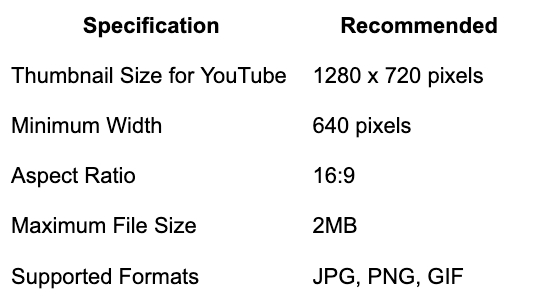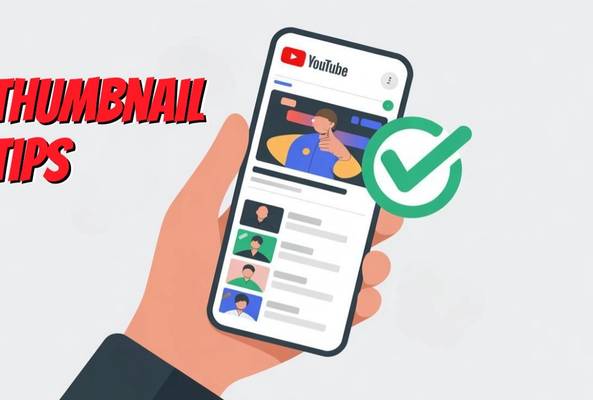In addition to being an avid movie and gaming enthusiast, Uttaran Samaddar is an experienced writer who has lent his creativity and unique perspective to various publications. He loves hearing and telling stories.
The Best YouTube Thumbnail Size and Dimensions for 2025
Your thumbnail is the first thing viewers see, so creating the best thumbnail for YouTube right is going to make your content pop-out to users. Using the wrong thumbnail size could make it appear blurry or cut off, a sure fire way to get your videos overlooked on YouTube.
Let's cover the exact YouTube thumbnail dimensions, file formats, and best practices to help your thumbnails look sharp on every screen.
Read More: 12 Types of YouTube Thumbnails People Love to Click On
The Best YouTube Thumbnail Size
For the best results, use these official YouTube thumbnail dimensions:

If your image isn’t naturally fit to become a YouTube thumbnail, try our YouTube Thumbnail Resizer Tool. It instantly formats your thumbnail to the ideal size for YouTube (1280 x 720), making it look sharp and professional.
But size is just one step toward creating the best YouTube thumbnail. You’ll need to consider a few more factors to make your video look professional across all platforms.
What Is Aspect Ratio?
Aspect ratio describes the proportional relationship between width and height. The 16:9 aspect ratio is the standard for most visual media, including YouTube and YouTube thumbnails. Using this aspect ratio means your image is 16 units wide for every 9 units tall.
While YouTube long form videos are 16:9, YouTube Shorts are 9:16.
This ratio matches YouTube’s video player and prevents your thumbnail from being cropped, stretched, or distorted.
Where Are YouTube Thumbnails Seen?
Your YouTube thumbnail is often the first impression viewers get of your content, showing up in multiple high-traffic areas, including:
- YouTube Search Results — Thumbnails appear alongside titles when users search for videos.
- YouTube Homepage & Recommended Feed — Your thumbnail competes for attention in the suggestions feed and home screen.
- Channel Page — Thumbnails line your video library, impacting how your channel looks to potential subscribers.
- Subscriptions Feed — Subscribers see your thumbnail in their feed when you upload new content.
- Social Media — When your video is shared outside YouTube, your thumbnail often displays as the preview image.
- External Sites — When your video is embedded, your thumbnail will be displayed until the viewer clicks play. And embeds can be any custom size.
Your thumbnail is going to be seen in both large and small formats, and getting the size just right keeps the design uncluttered.
How Do I Make My Thumbnail Look Sharp on All Devices?
Your thumbnail needs to look great on everything from mobile phones to Smart TVs. Here’s how to keep it sharp and clickable everywhere:
- Use high-resolution images at the recommended 1280 x 720 pixels.
- Stick to supported formats. The ideal choices are:
- JPG - which is the typical choice as it has a good quality and, since it’s generally smaller, has a faster loading time
- PNG - which is good for higher quality images
- Avoid uploading thumbnails smaller than 640 pixels wide.
- Test how your thumbnail looks at small sizes because most viewers see it in a tiny preview.
Why Do Simple YouTube Thumbnails Perform Better?
Your thumbnail will appear in crowded spaces like search results, suggested videos, and social feeds, often as a tiny image competing for attention. That’s why clear, uncluttered design makes all the difference.
Quick tips to make your YouTube thumbnails stand out:
- Limit text to 3-5 words max, bold and readable on mobile.
- Use high contrast colors to help your thumbnail pop.
- Focus on one clear subject—don’t overload the image.
- Test your design at small preview sizes.
- Stay consistent with your style to build brand recognition.
Pro Tip: If you are looking to replicate some popular thumbnail designs from your favorite creators, you can do so with vidIQ’s Thumbnail Templates tool.
What About YouTube Shorts Thumbnail Dimensions?
YouTube Shorts videos use a vertical 9:16 aspect ratio, typically 1080 x 1920 pixels. But when uploading a custom thumbnail from a desktop, YouTube applies the standard 1280 x 720 pixel, 16:9 thumbnail.
Important notes for Shorts thumbnails:
- Currently you cannot upload custom thumbnails for Shorts from a desktop.
- YouTube may auto-generate Shorts thumbnails.
- In the mobile app, when you edit a Shorts video, you will have the option to pick and edit a thumbnail.
Adding a custom YouTube Shorts thumbnail can be a bit tricky, but we tell you how to do it in this guide.
Mastering YouTube Thumbnail Creation
The right YouTube thumbnail size makes your videos look professional and helps attract more clicks. Stick to the recommended specs, design with your audience in mind, and use tools like vidIQ to streamline the process.
Ready to create better thumbnails? Try vidIQ’s AI Thumbnail Maker and start standing out today.
FAQs
What is the best size for YouTube thumbnails?
The recommended YouTube thumbnail size is 1280 x 720 pixels, with a minimum width of 640 pixels. This ensures your thumbnail looks sharp on all devices.
What is the ideal aspect ratio for YouTube thumbnails?
YouTube thumbnails should use a 16:9 aspect ratio, matching how videos display on the platform.
What size should YouTube Shorts thumbnails be?
YouTube Shorts are viewed in vertical format, but uploaded custom thumbnails still follow the standard 1280 x 720 pixel size and 16:9 ratio.
What file formats are supported for YouTube thumbnails?
While you can upload thumbnails in JPG, PNG, GIF, or BMP formats; most creators stick with JPG for fast loading or PNG for sharper details.
What’s the maximum file size for a YouTube thumbnail?
Thumbnails must be 2MB or smaller to be accepted by YouTube.
Do AI thumbnail makers adhere to proper dimensions and formats?
Yes, most AI thumbnail makers, including tools like vidIQ’s AI Thumbnail Maker, are designed to follow YouTube’s recommended specs by default. They help you create thumbnails at 1280 x 720 pixels, with the correct 16:9 aspect ratio, and in supported formats like JPG or PNG.






